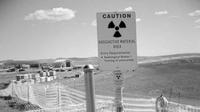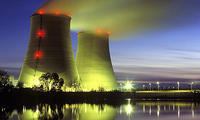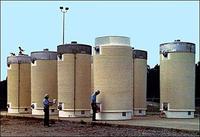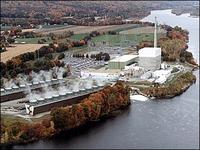-
Highly concentrated radiation found in Tokyo
A recent study indicates that radiation from the Fukushima Daiichi nuclear power plant, which suffered a meltdown following the 11 March earthquake and tsunami in Japan, has spread further and was more concentrated than previously thought
-
-
Cold War nuclear legacy challenges science, society

Fifty years of U.S. nuclear weapons production, and government-sponsored nuclear energy research and production, generated contaminated soil and groundwater covering two million acres in thirty-five states; for most of that period, the U.S. government did not have environmental structures, technologies, or infrastructure to deal with the problem
-
-
U.K. nuclear plants are safe: report

The United Kingdom has finalized a review of the implications of the Fukushima disaster for the U.K. nuclear power industry; Dr. Mike Weightman, the author of the review, said that the “U.K. nuclear facilities have no fundamental safety weaknesses”
-
-
MIT to help develop a nuclear reactor concept
MIT has been awarded $7.5 million to help develop a new nuclear reactor concept — the high-temperature salt-cooled reactor (also called a Fluoride-salt High-Temperature Reactor, or FHR); the FHR combines high-temperature graphite-matrix coated particle fuel developed for high-temperature gas-cooled reactors (fuel failure temperature > 1600 degrees C), liquid salt developed for the molten salt reactors (boiling point > 1400 degrees C), and safety systems originate from sodium fast reactors
-
-
French nuke industry struggles to boost public image
In an effort to curry favor with the public, for the first time France has opened the doors of its nuclear power plants for the country’s annual “heritage” event; public opinion polls indicate the French public have turned increasingly against nuclear power following the accident at Japan’s Fukushima Daiichi nuclear power plant
-
-
Siemens exits nuclear power industry

Siemens, the largest engineering conglomerate in Europe, and the company which built all of Germany’s seventeen nuclear power plants, said Sunday it was existing the nuclear power generation market; Peter Löscher, the chief executive of the Munich-based conglomerate, said: “The [nuclear] chapter for us is closed”
-
-
$90 million contracts for developing anthrax vaccine and antitoxin
HHS awards two companies contracts with potential value of $90 million for the advanced development of a novel next-generation anthrax vaccine and a new type of anthrax antitoxin
-
-
Japan nuke accident halves nuclear power growth
The nuclear meltdown at the Fukushima Daiichi plant appears to have caused nations around the world to reconsider nuclear projects; following the accident, demand for future nuclear projects has been halved
-
-
Microbes clean up nuclear waste -- and generate electricity
Researchers have discovered how microbes generate electricity while cleaning up nuclear waste and other toxic metals; the microbes effectively immobilize the radioactive material and prevent it from leaching into groundwater; the discovery could benefit sites changed forever by nuclear contamination
-
-
Earthquake moves Virginia nuclear waste casks

Last week’s earthquake saw caused nuclear waste casks to move up to four inches, and concrete pieces to peel off in concrete bunkers used for storing nuclear waste; the NRC says the casks and bunkers were not damaged, and no radiation leaked out
-
-
Molecules could help solve radioactive waste concerns
One component of nuclear waste — called “minor actinides” — present an extreme hazard as they are intensely radioactive and long-lived nuclides; they must be safely stored for at least 100,000 years; researchers have discovered a class of molecules that can selectively extract minor actinides, making the eventual waste far less radiotoxic
-
-
Teams dispatched to inspect Vermont nuclear plant following Irene

Following the torrential rains from Hurricane Irene on Sunday, federal officials have dispatched inspection teams to examine the aging Vermont Yankee nuclear plant to ensure that the plant has not been compromised; the plant has the same design as the Fukushima Daiichi plant in Japan which suffered a partial meltdown following the 11 March earthquake and tsunami
-
-
Uncovering mechanisms key to fusion reactor walls
A new tool will be hitched to an experimental fusion reactor at Princeton University to learn precisely what happens when extremely hot plasmas touch and interact with the inner surface of the reactor; fusion powers the stars and could lead to a limitless supply of clean energy
-
-
Radiation fears cripple Japanese food exports

Japanese agricultural exports have yet to recover from the 11 March earthquake and tsunami due largely to fears of radioactive contamination; to combat these fears, local governments have done all they can to assure consumers that their products are safe; consumers remain wary despite these reassurances, and as a result the Japanese agricultural sector is struggling
-
-
First quantitative measurements of Fukushima leakage
Atmospheric chemists report the first quantitative measurement of the amount of radiation leaked from the damaged nuclear reactor in Fukushima; the researchers calculated that 400 billion neutrons were released per square meter surface of the cooling pools, between 13 March, when the seawater pumping operation began, and 20 March 2011
-
- All
- Regional
- Water
- Biometrics
- Borders/Immig
- Business
- Cybersecurity
- Detection
- Disasters
- Government
- Infrastructure
- International
- Public health
- Public Safety
- Communication interoperabillity
- Emergency services
- Emergency medical services
- Fire
- First response
- IEDs
- Law Enforcement
- Law Enforcement Technology
- Military technology
- Nonlethal weapons
- Nuclear weapons
- Personal protection equipment
- Police
- Notification /alert systems
- Situational awareness
- Weapons systems
- Sci-Tech
- Sector Reports
- Surveillance
- Transportation
Advertising & Marketing: advertise@newswirepubs.com
Editorial: editor@newswirepubs.com
General: info@newswirepubs.com
2010-2011 © News Wire Publications, LLC News Wire Publications, LLC
220 Old Country Road | Suite 200 | Mineola | New York | 11501
Permissions and Policies
Editorial: editor@newswirepubs.com
General: info@newswirepubs.com
2010-2011 © News Wire Publications, LLC News Wire Publications, LLC
220 Old Country Road | Suite 200 | Mineola | New York | 11501
Permissions and Policies
